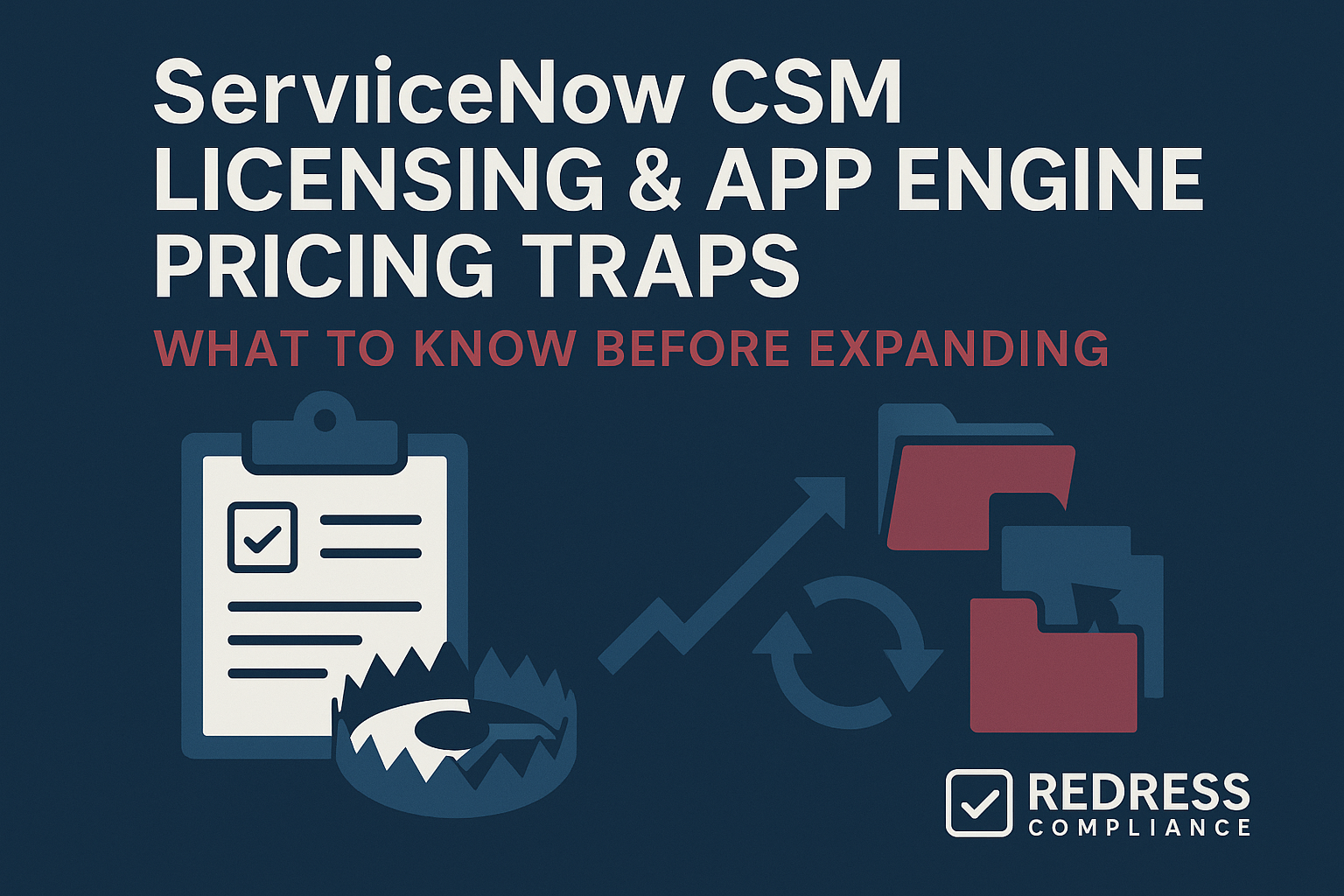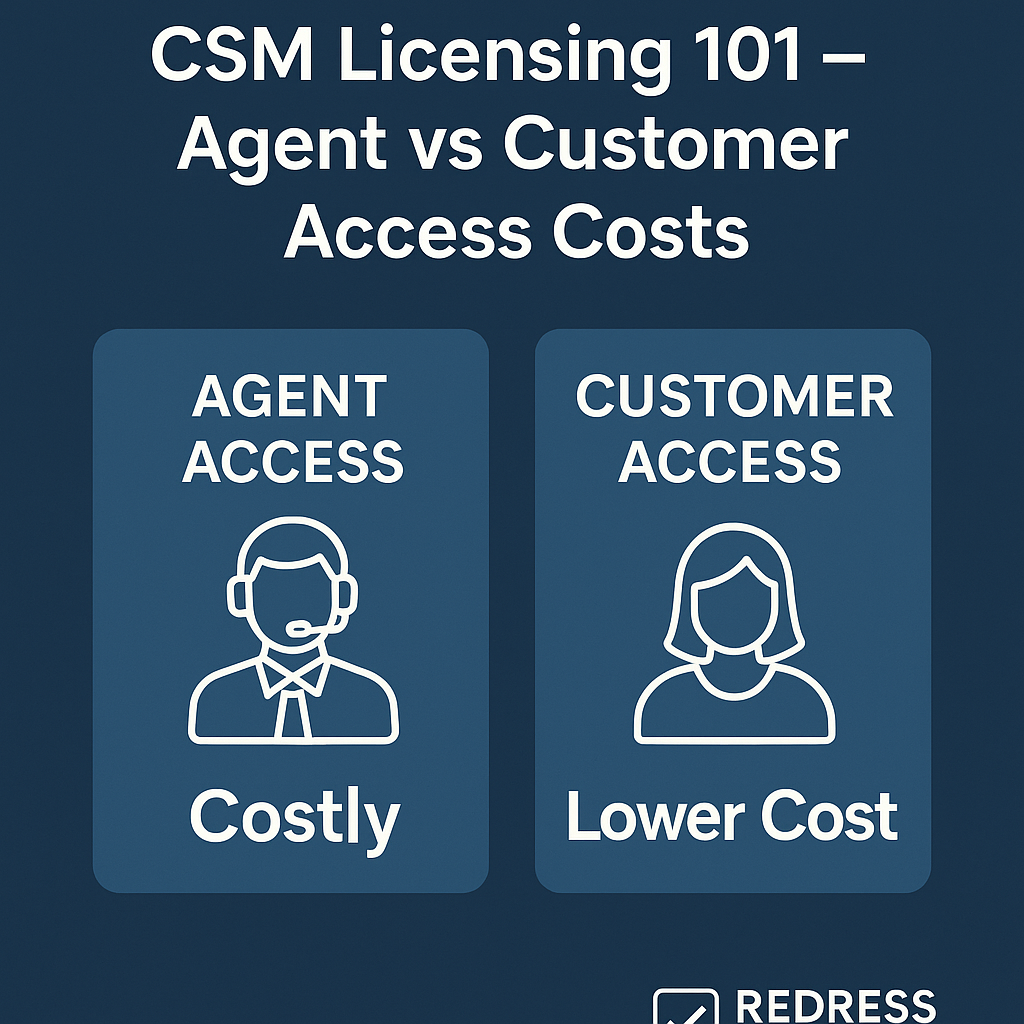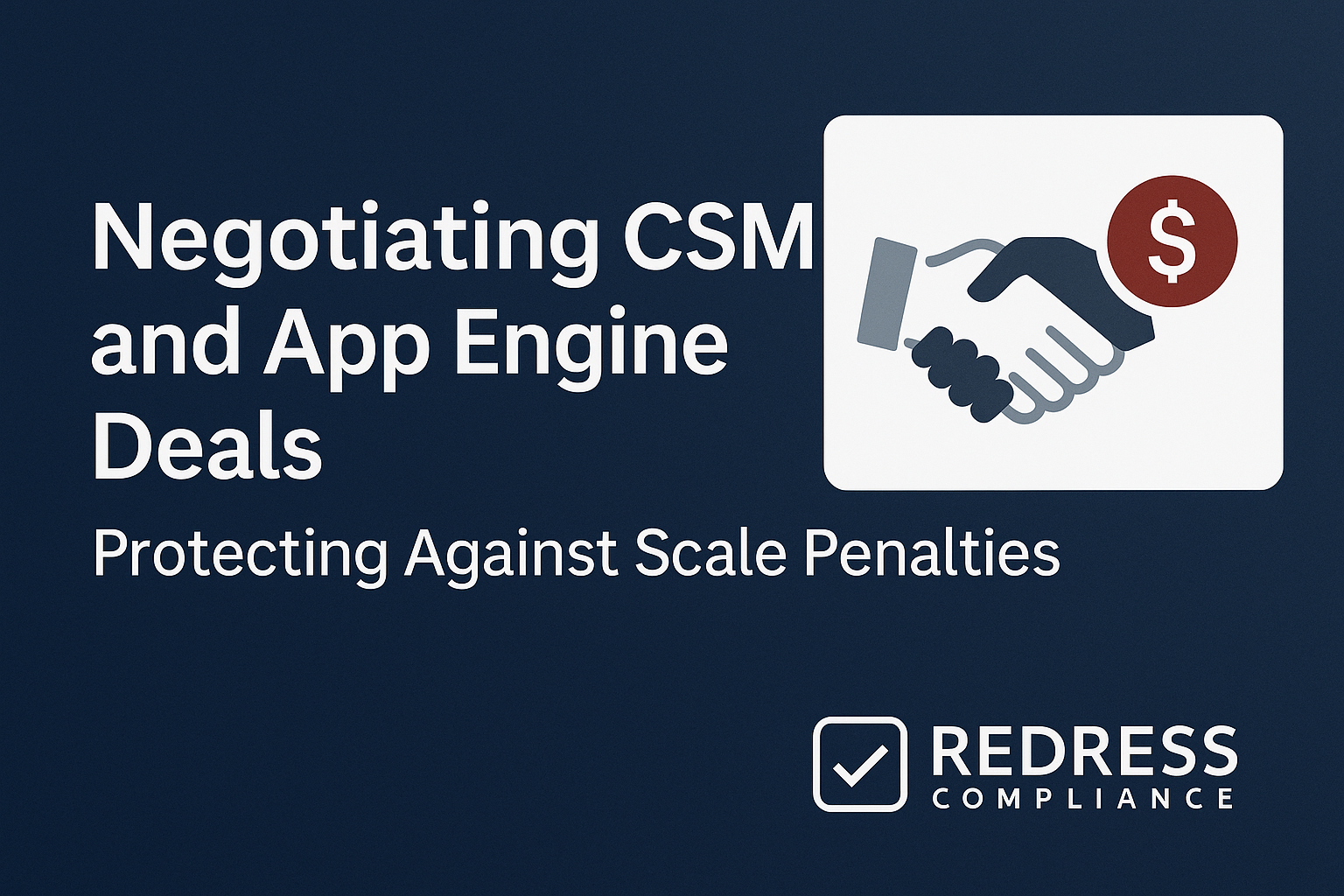ServiceNow CSM Licensing & App Engine Pricing – Expansion Traps to Avoid
Expanding your ServiceNow platform beyond IT Service Management (ITSM) can lead to unexpected costs.
New product lines like Customer Service Management (CSM) and the Now Platform App Engine aren’t covered under your existing ITSM licenses – they come with separate, often higher, licensing fees and rules. Too often, companies assume they can just turn on these modules, often resulting in sticker shock when a quote arrives.
For example, a mid-sized insurer added CSM, expecting to reuse its ITSM pricing. Instead, the expansion quote came back about 35% higher per user than their ITSM licenses. This is because CSM and App Engine use different (premium) licensing models with unique entitlements.
To illustrate, here’s a quick comparison of how CSM vs App Engine licensing differ:
| Licensing Aspect | ServiceNow CSM (Customer Service) | ServiceNow App Engine (Low-Code) |
|---|---|---|
| Primary metric | Per named agent (fulfiller) – each support agent needs a license. | Per user (for those accessing custom apps) or by app capacity – depending on edition. |
| Included in ITSM plan? | No. CSM must be purchased separately (CSM licenses do include standard ITSM features for those users). | Partially. Many ITSM packages include an App Engine Starter (limited apps). Full App Engine requires a separate purchase. |
| Relative cost | High: Often 30–40% more per user than core ITSM licenses (due to added customer support capabilities). | High (when scaled): Starter is free for 1–2 apps, but upgrading to unlimited apps (Enterprise) adds significant per-user cost. |
| Scalability factors | More agents = higher cost (plan for volume discounts). External customer portal users are free. | More apps/users = higher tier needed. Exceeding starter limits triggers a costly Enterprise upgrade. |
Why Expansion Comes with Pricing Surprises
Moving into CSM or App Engine isn’t like installing a simple add-on. Each of these expansions introduces a new licensing model and often a premium price tag.
In other words, ServiceNow treats them as separate product lines with their own SKUs and terms – rather than extensions of your existing ITSM deal. This is why organizations often experience sticker shock when expanding. You might budget assuming the same per-user costs as ITSM, but find out the new module is much pricier.
Understanding Customer Service Management (CSM) Licensing
ServiceNow CSM is licensed per fulfiller (each internal support agent needs their own license). CSM licenses typically cost 30–40% more per user than standard ITSM licenses. Why the premium? Because a CSM license usually includes core ITSM capabilities for that same user. In other words, a customer service agent with a CSM license can also work on incidents and other IT tasks (while an ITSM-only license cannot work on customer cases). It’s essentially a superset license, covering more functionality than ITSM alone.
CSM also offers various add-ons, such as Digital Engagement (chat/messaging features), industry-specific CSM packages, and Field Service extensions. Each of these has its own cost, so only include the extras that are necessary for your business.
Pro Tip: If you anticipate needing more CSM agents in the future, negotiate tiered pricing or volume discounts now. Don’t let a larger team later be priced at full list – secure a scaled pricing band in your contract so your cost per agent goes down as you add more.
Internal vs. External Users in CSM
The good news: you don’t need to license your external customers. All those end-users creating cases via the portal are free. You only pay for the internal team (agents and support staff) who work on the cases.
However, a flood of customer issues can still raise costs indirectly. If case volumes spike, you might need to add more agents (more CSM licenses). High usage can also eat up integration capacity – for example, connecting ServiceNow to a CRM or ERP may require an Integration Hub add-on for additional transactions. In short, external users are free, but serving a lot of them can trigger extra internal costs.
Pro Tip: Keep an eye on your customer portal metrics. If case counts are rising month over month, forecast the impact on agent staffing and related licenses early. By monitoring portal usage trends, you can anticipate when to budget for additional CSM agents or extra integration capacity before performance suffers.
How App Engine Licensing Works (and Why It’s Confusing)
In many cases, you get a small App Engine Starter included in your license (allowing maybe 1–2 custom apps). But if you exceed that, you must upgrade to a paid App Engine Enterprise license. Enterprise unlocks unlimited custom apps, but each user of those apps requires an App Engine license, which can add up fast.
Pro Tip: If your team plans to build more than a couple of custom applications, address App Engine licensing upfront. It’s often cheaper to negotiate a full App Engine Enterprise package early (as part of a larger deal) than to be forced into a costly upgrade later. Plan for success – assume your app footprint will grow and make sure your licenses can accommodate it.
Creator Workflows vs. App Engine – Same Concept, Different Branding
ServiceNow has rebranded its custom app platform over time (“Creator Workflows” vs “App Engine”), but it’s essentially the same thing. No matter the name, the licensing follows the same rules – usually a limited Starter tier vs. a full Enterprise tier – so focus on the entitlements rather than the product name.
Pro Tip: Always read the fine print on your ServiceNow order form or SKU list. If you see something like “App Engine Starter” or “Creator” licenses, confirm what the limits are. Don’t assume a different name means more capability – often it’s just marketing. Know exactly what you’re entitled to build (or how many users can access those apps) before hitting a usage cap.
Common Expansion Traps (and How to Avoid Them)
As companies expand into CSM or App Engine, certain pitfalls crop up repeatedly.
Below are some common expansion traps to watch for, along with their cost impact and how to avoid them:
| Trap | Description | Cost Impact | Avoidance/Mitigation |
|---|---|---|---|
| Underestimating CSM Agent Needs | Starting with a small CSM pilot, then needing far more agents than planned. | High – budget overruns from unplanned licenses at list price. | Negotiate price breaks for higher agent tiers now, so additional users later are cheaper. |
| “Free-to-Fee” App Engine Surprise | Building more custom apps than the free App Engine Starter allows, triggering a paid upgrade mid-term. | High – sudden six-figure costs to license apps & users unexpectedly. | Plan your app roadmap and include App Engine Enterprise in your agreement if your app count will grow. |
| Integration Hub Oversight | Not realizing integrations (to CRM, ERP, etc.) require an Integration Hub license until after implementation. | Medium – extra costs for integration entitlements or transaction packs. | If you know you’ll connect ServiceNow to other systems, bundle some Integration Hub capacity in your deal upfront. |
| Industry SKU Upcharges | Buying an industry-specific CSM package (e.g. for telecom or finance) when standard CSM would suffice. | Medium–High – industry versions cost ~25–35% more than base. | Only opt for industry SKUs if those specialized features are truly necessary. Otherwise stick to the standard version. |
| Overlapping Licenses | Giving the same user both an ITSM and a CSM license because they work on both incident and case modules. | High – effectively double-paying for one person. | Avoid duplication: a CSM fulfiller license covers ITSM tasks too. Use one license per person by aligning roles appropriately. |
Pro Tip: Before expanding, perform an internal audit of user roles and planned use cases. Identify any overlap (like agents who handle both IT and customer support) and ensure you’re not paying twice for the same individual. Also, validate any technical needs (integrations, special features) early so you can address them in your licensing discussions rather than as an afterthought.
Negotiation & Mitigation Strategies
You’re not at the mercy of surprise quotes – with the right approach, you can negotiate and mitigate many of these costs.
Consider these strategies before you expand:
- Start with a pilot: Instead of committing to hundreds of CSM or App Engine licenses upfront, begin with a small pilot. For example, try 10 CSM agents for 6–12 months, or a limited App Engine use case. Crucially, include terms that let you expand later at a pre-negotiated rate if the pilot succeeds. This approach demonstrates value and provides real usage data to negotiate a better deal later on.
- Secure price protections for growth: Ensure your contract locks in the pricing for future expansion. For example, if you add more CSM agents or need to upgrade App Engine later, stipulate that those additions will use the same discounted per-unit rate you negotiated initially.
- Bundle new modules with renewals: The best discounts usually come when you fold new purchases into a big renewal or Enterprise License Agreement. If you’re eyeing App Engine Enterprise or CSM, try to bundle it with your upcoming renewal rather than as a mid-term add-on. You might secure a much better rate. One financial firm even negotiated a 25% lower price lock on future App Engine licenses during their ELA – saving about $400K when they later scaled up their low-code app portfolio.
Pro Tip: Whenever possible, time expansions with your renewal cycle or ELA negotiations. Adding modules or users mid-term (when you have less leverage) often means paying closer to list price. By aligning a CSM or App Engine purchase with a larger deal, you give yourself more bargaining power for discounts.
Cost vs. Value – When Expansion Is Worth It
While these licenses are expensive, they can be worth the investment if they deliver strong business value. Always weigh cost versus benefit.
For example, implementing ServiceNow CSM might replace multiple older customer support systems. A retail company did this – consolidating five legacy support tools into ServiceNow. Their licensing costs increased with CSM, but they saw roughly a 40% improvement in support efficiency and were able to retire those other tools, saving money and streamlining operations.
The key is to make sure expansion aligns with a real need and that you’re shedding redundant costs elsewhere. If CSM replaces another CRM or support tool, factor those savings into your ROI. If App Engine lets you avoid buying several niche software products, that’s a budget win.
And in discussions with executives, frame the expansion cost as a reallocation of spend, not purely an extra expense. You’re moving your budget from older solutions to a more powerful unified platform – a shift that’s easier to justify when the benefits are clear.
Read related articles
- ServiceNow CSM Licensing 101 – Agent vs Customer Access Costs
- CSM Expansion Traps – How Growing Customer Volume Impacts Costs
- Controlling ServiceNow App Engine Costs – Avoiding Overages and License Limit Traps
- Negotiating CSM and App Engine Deals – Protecting Against Scale Penalties
- App Engine & Creator Workflows License Model – Understanding the Costs
5 Insightful Next Steps for Buyers
If you’re preparing to expand into ServiceNow CSM or App Engine, consider these next steps to move forward wisely:
- Review your current ServiceNow licenses. See if your contract already includes any CSM or App Engine entitlements (even a small starter pack).
- Map out a 12–24 month roadmap. Outline how many customer service agents or custom apps you anticipate over the next year or two. This will help you size the licenses needed and strengthen your position when negotiating pricing.
- Run cost scenarios for growth. Model a “what if” scenario – for example, adding 20 CSM agents or building 10 custom apps. Understand at what point you’d hit a new licensing tier or need to upgrade to the next package. No surprises = no panic spending.
- Ask ServiceNow for tiered pricing options. Don’t settle for a single flat rate quote. Get pricing for different volumes (e.g., 50 agents vs 100, or basic vs full App Engine) to see where better price breaks kick in.
- Maximize what you have first. Before leaping into new modules, make sure you’re fully utilizing your current ServiceNow capabilities. For instance, could ITSM’s existing functionality handle a simple external workflow for now? Or could a basic configuration solve the problem instead of building a whole new custom app? Use what you’ve got to its limits – then expand when you truly need the extra power.
Read about our ServiceNow Advisory Services.


